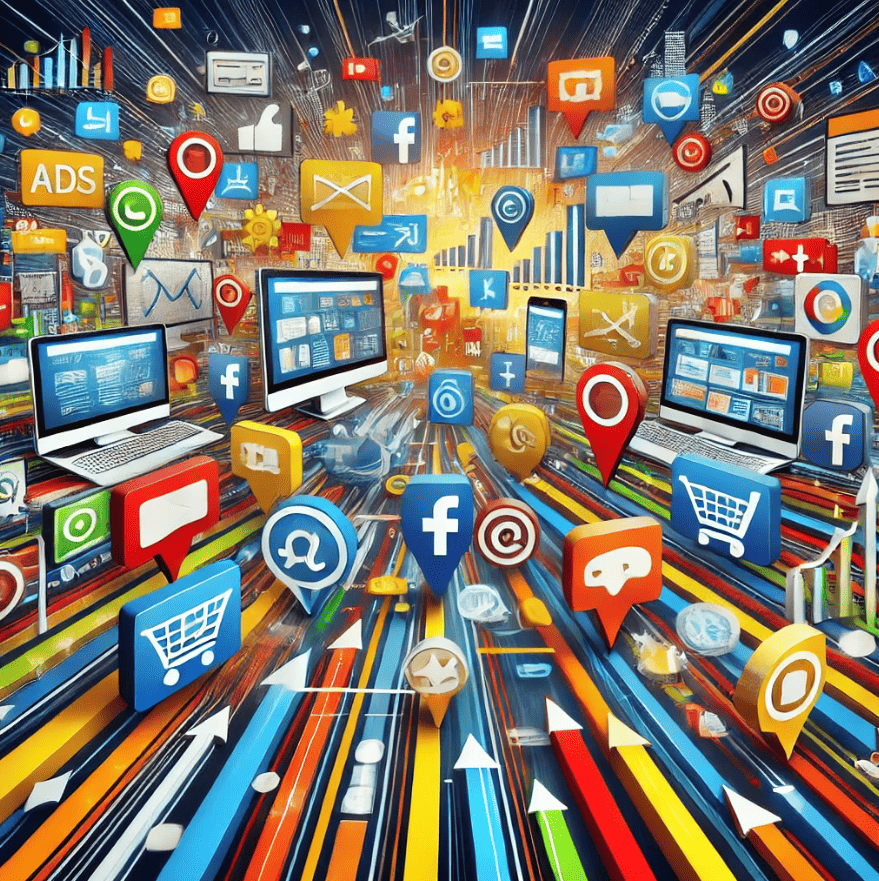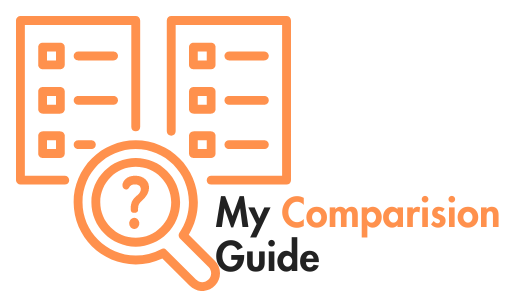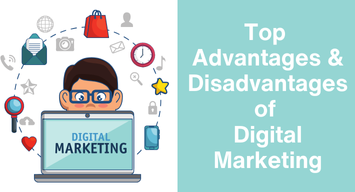Introduction
Digital marketing has transformed how companies engage with their target audience.
In our chaotic lives, it is an unavoidable method of reaching new clients, encouraging brand exposure, and generating sales. However, like any powerful method, digital marketing has its own challenges.
In this blog post, we will discuss the advantages and disadvantages of digital marketing in 2025, as well as demonstrate ways for businesses to approach the uncertain ground of digital marketing practice.
Moreover, we are also going to share the various digital marketing benefits, which include accessibility, cost-effectiveness, and measurability. Also, there are various challenges, such as over-saturation, privacy issues, and technical issues. It’s beneficial to understand that both aspects will inform and clarify a decision regarding a digital marketing strategy and the outcome.
Advantages of Digital Marketing for 2025
1. Wider Reach and Global Access

Wider Reach and Global Access expand the doors of modern marketing. It is allowing businesses to reach audiences across the globe, which is not possible with traditional marketing. It allows for targeting numerous customers residing in various different regions by making use of digital marketing platforms, like social media, search engines, and email services.
Moreover, this would allow an SME to scale on a larger and bigger level without necessarily having to be based in several locations. Thus, through an extension of outreach, businesses can enter overseas markets and attract diverse customers who would previously not have been known, further enhancing the potential for growth and increased brand exposure.
2. Cost-effective Marketing Solutions

As compared to traditional marketing, digital marketing offers cost-effective solutions to business owners. On digital marketing platforms such as social media, email marketing, and search engine ads, businesses can run campaigns with flexible budgets, allowing even small companies to compete on a global scale with affordable options that yield measurable results.
In addition, it enables very precise targeting of clients. For example, if you are a local business, you can use social media ads or Google Ads to target your clients by pin code or geographical area. Moreover, they also offer daily budget and lifetime budget options for businesses to promote on digital platforms. This efficiency helps optimize budgets, reducing wasted spend and maximizing return on investment (ROI), making it a highly appealing option for businesses seeking to grow without excessive costs.
3. Advanced Targeting with AI and Machine Learning

Advanced targeting with AI and machine learning significantly enhances digital marketing by enabling precise audience segmentation and personalized content delivery. These AI technologies analyze huge amounts of data to identify patterns and predict customer behavior, allowing marketers to target specific demographics, interests, and behaviors more accurately. This leads to more relevant and engaging advertisements, higher conversion rates, and improved ROI.
Additionally, AI and machine learning can optimize ad placements and bids in real-time, ensuring that marketing efforts are both efficient and effective. By leveraging these advanced tools, businesses can create more impactful and tailored marketing campaigns that resonate with their target audience.
4. Real-Time Performance Tracking

One of digital marketing’s major advantages is the ability to monitor campaign metrics in real time. This technique allows marketers to see what is going on quickly, determine trends, evaluate the effectiveness of the implemented strategies, and immediately make adjustments to optimize results. Some key metrics measured in real time include website traffic, conversion rates, click-through rates, and engagement levels. Using these forms of data can amplify marketers’ decision-making abilities, align them with better customer targeting, and maximize ROI.
5. Increased Customer Engagement

Increased customer engagement is one of the most important aspects of digital marketing. It refers to the enhanced interaction between businesses and their customers through digital marketing channels. By using social media channels such as Facebook, Instagram, and more, along with email campaigns and personalized content, businesses can engage and connect with customers in real-time, observing their needs and preferences more effectively. This continuous interaction with clients builds stronger relationships, boosts customer loyalty, and encourages repeat business.
Moreover, it allows companies to gather valuable feedback and insights from clients, enabling them to refine their strategies and improve customer satisfaction.
6. Improved conversion rates

Improved conversion rates are one of the most significant benefits of digital marketing. This refers to the increased percentage of visitors who take a desired action on your website, such as purchasing, signing up for a newsletter, or filling out a form.
Using digital marketing strategies such as advertising, personalized content, and A/B testing helps optimize user experience and engagement. This leads to higher conversion rates by effectively guiding potential customers through the sales funnel, reducing friction points, and addressing their needs more precisely. Ultimately, improved conversion rates result in better return on investment (ROI) and business growth.
7. Omnichannel Marketing Opportunities

I hope you have heard about omnichannel marketing. If not, let me explain it to you. Omnichannel marketing is a strategy that integrates various channels of communication to deliver a consistent and seamless customer experience across multiple platforms, such as online, in-store, social media, and mobile apps. This practice ensures that clients receive consistent messaging and can interact with a brand through their preferred channels, improving customer satisfaction and loyalty.
By using this strategy, businesses can understand customer behavior, personalize marketing efforts, and drive higher engagement and sales for their products or services.
8. Flexible Campaigns
As Compared to traditional marketing, digital marketing offers greater flexibility in campaigns. It allows for the quick adjustment and optimization of marketing strategies based on real-time data and performance metrics. Additionally, digital campaigns can be easily modified to respond to market trends, customer behavior, and feedback. This flexibility enables businesses to experiment with various approaches, target specific audiences more effectively, and allocate budgets more efficiently.
As a result, flexible campaigns help maximize return on investment (ROI) and ensure that marketing efforts remain relevant and impactful.
9. Enhanced Content Creation with AI Tools

In today’s fast-paced world, every organizer tries to adopt AI tools in their business. Digital marketers are also trying to integrate AI tools to enhance content creation. As you know, AI tools have the ability to elevate your content creation process. Artificial intelligence (AI) can assist in generating high-quality content quickly, from blog posts and articles to social media updates, image creation, and video scripts. These tools offer features like grammar correction, style suggestions, and even content ideation, making it easier for marketers to produce engaging and relevant material.
By leveraging AI tools, online creators can save a lot of time, reduce costs, and maintain a consistent content output, ultimately enhancing their digital marketing efforts.
10. Sustainability and Eco-Friendly Marketing
Nowadays, almost every business wants to do marketing through digital channels. Digital promotion helps businesses reduce their environmental impact by minimizing the use of physical materials like paper for flyers or fuel for transportation, thereby reducing their carbon footprint. Additionally, digital marketing allows for precise targeting, reducing waste associated with broad, untargeted campaigns.
This approach not only helps the planet but also resonates with eco-conscious consumers who appreciate brands that care about sustainability. Embracing these practices can boost your brand’s image and contribute to a healthier planet.
Example: Companies that switch to email marketing or digital ads instead of print campaigns not only save on costs but also contribute to sustainability efforts by reducing paper waste and ink use.
Case Study: Patagonia, an outdoor clothing company known for its environmental advocacy, uses digital marketing to promote its sustainability initiatives. By sharing content about environmental conservation on social media and through email newsletters, Patagonia strengthens its eco-friendly brand image without relying on printed materials.
11. Measurable ROI
One of the key advantages of digital marketing is the ability to measure return on investment (ROI) with precision. Unlike traditional marketing channels like print or television, digital platforms allow marketers to track specific metrics such as conversions, click-through rates (CTR), and customer lifetime value. Tools like Google Analytics, Facebook Insights, and various customer relationship management (CRM) systems help businesses track the performance of their campaigns and allocate budgets more effectively.
Example: E-commerce companies use conversion tracking to assess the profitability of paid ad campaigns. If a company spends $1,000 on Google Ads and earns $3,000 in sales, the ROI is measurable, making it easier to determine whether the campaign is effective.
Case Study: The Red Door Interactive implemented ROI tracking for their client, an outdoor apparel company. By analyzing campaign performance through various digital channels, they identified which campaigns generated the highest returns, leading to a 200% increase in online sales.
12. Personalization
Digital marketing enables businesses to create highly personalized content for users. With data on customer preferences, browsing history, and demographics, marketers can tailor their messages to suit individual needs. Personalization increases engagement and customer satisfaction, which often leads to higher conversion rates.
Example: Amazon is a leader in personalized marketing. By using algorithms that track user behavior, Amazon recommends products based on browsing history and purchase patterns. This level of personalization makes customers feel valued and understood, increasing the likelihood of repeat purchases.
Case Study: Coca-Cola launched the “Share a Coke” campaign, which personalized bottles with names. This marketing strategy leveraged the power of personalization to create an emotional connection with customers. The campaign resulted in a 2% increase in U.S. sales and a boost in social media engagement, showcasing the effectiveness of personalized marketing.
13. Scalability
Digital marketing campaigns are easily scalable, meaning businesses can start with small budgets and expand based on performance. Whether you’re a small business or a large enterprise, digital platforms offer flexibility in terms of budget allocation. If a campaign performs well, marketers can invest more resources to increase its reach.
Example: Startups often begin with a small ad budget on platforms like Facebook or Google Ads. If they see positive results, they can scale their campaigns by increasing their ad spend without having to completely overhaul their strategies.
Case Study: Dollar Shave Club started with a small marketing budget and a humorous viral video on YouTube. As the video gained traction, the company scaled its marketing efforts across multiple platforms. The campaign’s scalability played a significant role in helping Dollar Shave Club grow from a startup to a billion-dollar acquisition by Unilever.
15. Enhanced customer insights
Digital marketing provides access to vast amounts of data about customer behavior, preferences, and demographics. Businesses can use this data to improve their understanding of their target audience, refine their messaging, and develop more effective marketing strategies.
Example: Netflix uses customer insights to recommend shows and movies to its users. By analyzing data on viewing habits, Netflix provides personalized content suggestions that keep users engaged and subscribed to the service.
Case Study: Spotify leveraged customer insights to create personalized playlists like “Discover Weekly” and “Wrapped,” which show users their top music choices of the year. This approach increased customer loyalty and social sharing, enhancing Spotify’s brand presence globally.
16. Data-Driven Decisions
The ability to make decisions based on real-time data is another critical advantage of digital marketing. Marketers can track the performance of campaigns and adjust strategies based on the data they collect. This allows businesses to optimize campaigns quickly, ensuring higher effectiveness and better use of resources.
Example: A clothing brand might notice that a specific Instagram ad is performing well among younger users. With real-time data, the brand can allocate more budget to this ad and create similar content to boost engagement among that audience segment.
Case Study: Nestlé used data-driven decision-making to revamp its marketing strategy. By analyzing data on consumer behavior and preferences, the company shifted its focus to digital campaigns targeting younger audiences. This resulted in a significant increase in engagement and online sales.
17. Brand Awareness
Digital marketing is a powerful tool for building brand awareness. Social media platforms, influencer marketing, and content marketing help businesses reach new audiences and establish their presence in the market. Brands can engage with customers through storytelling, shareable content, and interactive experiences, all of which contribute to increased visibility.
Example: Nike uses digital platforms like Instagram and Twitter to engage with users through shareable content and partnerships with influencers. These efforts not only promote products but also reinforce Nike’s brand message of empowerment and innovation.
Case Study: Old Spice completely revamped its brand image through a digital marketing campaign called “The Man Your Man Could Smell Like.” The campaign went viral on social media, resulting in a 125% increase in sales within six months. Old Spice successfully used digital channels to reach a younger audience and build brand awareness.
18. Cost-effective A/B Testing
Digital marketing allows businesses to experiment with different versions of ads, emails, or landing pages to determine which performs best. This A/B testing feature is not only cost-effective but also provides valuable insights into customer preferences.
Example: An e-commerce company may create two different versions of an email campaign—one with a discount offer and one without—and send them to a small segment of their email list. By analyzing which version generates more clicks and conversions, the company can scale up the winning strategy.
19. Interactive Content
Digital marketing allows businesses to engage their audience through interactive content such as polls, quizzes, and videos. Interactive content not only increases engagement but also provides valuable data on customer preferences and behaviors.
Example: BuzzFeed has mastered the art of using quizzes to engage readers. These quizzes often go viral, increasing site traffic and social shares while also providing insights into what types of content their audience enjoys.
Case Study: Sephoralaunched a Virtual Artist app that allowed users to try on makeup virtually. This interactive experience increased customer engagement and helped Sephora gather valuable data on customer preferences, leading to a more personalized shopping experience both online and in-store.
Disadvantages of Digital Marketing for 2025
1. Increased Competition

Digital marketing is a crowded space, with many businesses competing for people’s attention. Even smaller and less significant companies can easily create an online presence due to low entry barriers. This makes it harder to capture and maintain audience attention, as well as ensure customer loyalty.
Additionally, digital marketing demands swift innovation to stay ahead of competitors. As a result, companies need to invest more time and resources to stay competitive in this hyper-competitive market.
2. Ad fatigue among consumers
Ad fatigue among consumers refers to how people become tired and less responsive to ads due to overexposure. In digital marketing, consumers see a high number of ads across various media. This constant exposure can lead to irritation, reduced interaction, and even complete avoidance of ads.
As a result, businesses might see lower success rates in their campaigns. To combat this fatigue, marketers need to create new, relevant, and strategically placed ads to keep their target audiences engaged and interested.
3. Privacy Concerns

Simply put, privacy issues in digital marketing relate to the issues of data collection and its usage. Marketers collect massive amounts of data in order to design their campaigns; they are actually worried about who is dealing with and safeguarding it. The awareness about their rights regarding privacy and raising awareness about how the information obtained from them was being utilized, circulated, or probably misused is ever increasing among the consumers.
If there is no trust, there would be a lack of engagement as well as possibly some law-related actions against some companies who do not protect the data of their clients according to the requirements. Data protection will be very safe if transparency can be achieved first, keeping customer data secure.
4. Dependence on Technology
One thing is for sure: the digital marketing sector is heavily dependent on the various devices and applications that businesses use. While this leads to successful campaign marketing, it also has some negative effects. These include technical problems that can disrupt marketing campaigns and the rapid growth of the tech industry, making it difficult to stay on top of new systems.
Additionally, the main obstacle is the slow work pace due to the learning curve. Employees need time to learn how to use new tools, which can slow down marketing efforts. Only when these aspects are secure will businesses be able to overcome potential technological challenges that might hinder marketing results.
5. Skill gaps

Skill gaps are a major disadvantage in digital marketing. They refer to the discrepancy between the skills that businesses need and the skills that employees possess. As technology rapidly evolves, new tools and platforms emerge, requiring marketers to continually upgrade their knowledge and abilities.
However, not all employees can keep up with these changes, leading to gaps in expertise. This can hinder the effectiveness of marketing efforts and require businesses to invest in training programs or hire specialized talent, both of which can be time-consuming and costly.
6. High Initial Learning Curve
As you know, digital marketing is skill-based, and you need to learn well if you want to succeed in this sector. It requires a significant amount of time and effort to master new tools, platforms, and strategies. For people who are not tech-savvy, or for businesses and marketing agencies that lack technological expertise, adopting digital marketing can be challenging.
The processes of understanding analytics, managing campaigns, and using various digital tools demand substantial learning and training. This steep learning curve can delay the execution of marketing strategies and require additional resources for education and support. Ultimately, businesses need to invest time and effort to acquire the necessary skills and competencies to thrive in the digital marketing environment.
7. Algorithm Changes
Do you know what an algorithm is? It is a set of step-by-step instructions or rules designed to perform a specific task or solve a particular problem. Every internet-based company has its own algorithms, and they update them regularly, which can be challenging for digital marketers.
The term algorithm changes refers to the frequent updates and changes by digital platforms such as Google, Facebook, and Instagram to their respective algorithms. These changes can affect the way content is ranked and shown, which affects how much a digital marketing campaign will show up and how effective it will be.
As the industry evolves, marketers must stay on top of these updates to ensure that they have maximum leverage. Not enough attention paid to any algorithm changes could severely affect their campaigns through reduced traffic, engagement, and conversions. A challenge that is never going to end for any business is the need for continuous exertion and, therefore, vigilance in adapting one’s marketing strategy.
8. Risk of Negative Feedback
If you easily get positive feedback on your online company, then there might be a high chance that you could also receive negative feedback in digital marketing. There are many ways you can receive negative feedback in the form of unfavorable comments and reviews from customers. With the transparency and reach of digital platforms, a single negative review or complaint can quickly spread and impact a brand’s reputation. This risk is heightened by the immediacy of social media and review sites, where consumers can easily share their experiences.
9. Cybersecurity Threats

Cybersecurity in digital marketing involves various risks, such as data breaches, phishing attacks, and malware attacks on your business. Nowadays, hackers can exploit vulnerabilities in online systems to steal sensitive information, including customer data and payment details. This not only compromises user privacy but also tarnishes the brand’s reputation, leading to significant losses for any business. Additionally, digital marketing campaigns can be targeted by cybercriminals through fraudulent activities like click fraud, which can drain advertising budgets.
To address these cybersecurity threats, businesses must invest in robust cybersecurity practices, including encryption, secure servers, and regular updates. These measures help mitigate risks and ensure the protection of both the company’s and their customers’ data.
10. Time-Intensive
One downside of digital marketing is that it takes a lot of time to learn and understand. It’s not just about posting something online and walking away. You have to create good content that resonates with your target audience, manage different social media accounts to keep your business reliable and updated, and track the performance of your ads and posts.
On top of that, you need to respond to customers as quickly as possible, keep up with the latest trends, and make changes to your strategy if things aren’t working. You need a lot of trial and error to become successful in any campaign you run. All of this can eat up a lot of your time, making it hard to focus on other important parts of your business.
11. Ad Blindness

Ad blindness refers to the phenomenon where users consciously or subconsciously ignore banner ads, pop-ups, or any other type of online advertising. As consumers become more accustomed to digital ads, they tend to overlook them, reducing their effectiveness.
Example: Banner ads on websites often go unnoticed by visitors, especially if they appear in predictable locations or follow repetitive designs. Many users automatically ignore or skip them, even if the ad content might be relevant.
12. Limited Organic Reach
With changing algorithms and an increased emphasis on paid advertising, the organic reach of content on platforms like Facebook and Instagram has significantly declined. This shift forces businesses to invest in paid promotions to maintain visibility, especially for smaller businesses with limited budgets.
Example: A company might post content on Facebook, expecting it to reach a large portion of its followers. However, only a fraction of users see the post organically due to algorithm constraints. This forces the company to invest in ads to boost visibility.
13. Constant Content Demand
The demand for a steady stream of fresh, engaging content is another challenge in digital marketing. Consumers expect regular updates, blog posts, social media content, and videos. Keeping up with this demand can be time-consuming and costly, especially for smaller businesses.
Example: A fashion brand may need to post daily on Instagram, create weekly blog posts, and release monthly YouTube videos to maintain audience engagement. The constant pressure to generate content can be overwhelming.
14. Over-reliance on Paid Advertising
Many companies rely heavily on paid advertising to drive traffic and sales. While this can yield quick results, it creates dependency and can become expensive in the long run. If companies stop investing in ads, they may see a dramatic decline in website traffic, sales, and visibility.
Example: E-commerce businesses often use Google Ads or Facebook Ads to drive immediate traffic to their websites. However, if they reduce their ad budgets, their sales can plummet due to a lack of organic traffic or customer retention strategies.
15. Short-Term Focus
Digital marketing campaigns, especially those focused on paid advertising, can sometimes promote a short-term mindset. Businesses may prioritize immediate gains such as clicks or conversions, neglecting the importance of long-term strategies like brand building and customer loyalty.
Example: A startup may invest heavily in Google Ads to boost sales quickly but might overlook the need for long-term SEO optimization or email marketing to foster customer relationships.
16. Dependence on Platform Changes
Many digital marketing strategies are dependent on external platforms like Google, Facebook, or Instagram. When these platforms change their algorithms, businesses often need to quickly adapt their strategies. This dependence on third-party platforms can make businesses vulnerable to shifts beyond their control.
Example: A business that relies heavily on Facebook ads might experience a sharp drop in performance if Facebook changes its ad targeting algorithms or increases advertising costs.
17. Saturation of Content
With the explosion of digital content, many platforms have become oversaturated, making it increasingly difficult for businesses to stand out. This makes content creation and promotion more challenging, as companies need to produce unique and high-quality content to differentiate themselves from the competition.
Example: On platforms like YouTube or Instagram, millions of pieces of content are uploaded daily, making it hard for new or small creators to gain visibility unless they offer something truly distinctive.
18. Diminishing Attention Spans
The constant bombardment of digital content has resulted in shorter attention spans among users. Grabbing and retaining the attention of potential customers in a crowded digital space is becoming increasingly difficult, which can reduce the effectiveness of digital marketing campaigns.
Example: A user scrolling through their Instagram feed may only glance at an ad for a few seconds before moving on. If the content doesn’t immediately catch their attention, they are unlikely to engage or convert.
19. Ad Blockers
As more users install ad-blocking software, the visibility of online ads is decreasing. This reduces the effectiveness of digital marketing campaigns, especially those relying on display ads, banners, and pop-ups.
Example: A fashion brand might invest heavily in display ads on websites, but if a large portion of its target audience uses ad blockers, those ads won’t be seen, wasting the marketing budget.
20. Difficulty in Measuring Emotional Impact
While digital marketing provides excellent tools for tracking clicks, conversions, and engagement, it can be challenging to measure the emotional impact of digital ads. Unlike traditional forms of advertising, such as television commercials, digital ads often lack the ability to evoke strong emotional connections with consumers.
Example: A car manufacturer may run a highly engaging TV commercial that resonates emotionally with viewers, but the same emotional impact might not translate as effectively in a banner ad or social media post.
FAQs: Advantages and Disadvantages of Digital Marketing in 2025
Advanced personalization, data-driven insights, and global reach.
Privacy concerns, increased competition, and algorithm dependence.
AI enables hyper-targeted content based on detailed consumer behavior and preferences.

